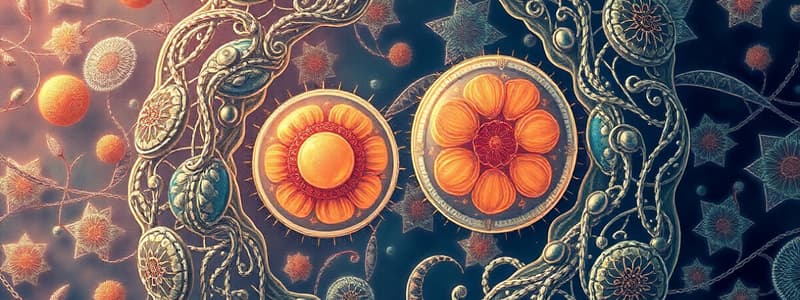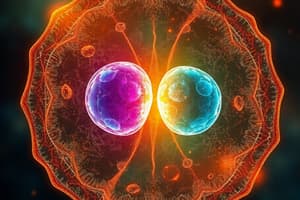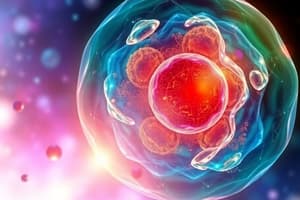Podcast
Questions and Answers
Which of the following is NOT a phase of mitosis?
Which of the following is NOT a phase of mitosis?
- Prophase
- Metaphase
- Interphase (correct)
- Anaphase
Mitosis produces daughter cells with the same number of chromosomes as the parent cell.
Mitosis produces daughter cells with the same number of chromosomes as the parent cell.
True (A)
What is the primary purpose of meiosis?
What is the primary purpose of meiosis?
To produce gametes (sex cells) with half the number of chromosomes as the original cell.
During ______, chromosomes line up in the middle of the cell.
During ______, chromosomes line up in the middle of the cell.
Match the following terms related to mitosis and meiosis with their descriptions.
Match the following terms related to mitosis and meiosis with their descriptions.
Cell theory states that all living things are composed of at least one cell.
Cell theory states that all living things are composed of at least one cell.
What is the primary purpose of mitosis in multicellular organisms?
What is the primary purpose of mitosis in multicellular organisms?
The process of ______ is responsible for the division of somatic cells in humans.
The process of ______ is responsible for the division of somatic cells in humans.
What is the difference between mitosis and meiosis in terms of the resulting daughter cells?
What is the difference between mitosis and meiosis in terms of the resulting daughter cells?
Match the following terms with their correct definitions:
Match the following terms with their correct definitions:
Meiosis is responsible for the repair and regeneration of damaged tissues in the body.
Meiosis is responsible for the repair and regeneration of damaged tissues in the body.
What is the outcome of both mitosis and meiosis?
What is the outcome of both mitosis and meiosis?
Why is mitosis important for cardiorespiratory health?
Why is mitosis important for cardiorespiratory health?
Which of the following statements correctly describes the difference between mitosis and meiosis?
Which of the following statements correctly describes the difference between mitosis and meiosis?
During mitosis, the number of chromosomes in the daughter cells is half the number of chromosomes in the parent cell.
During mitosis, the number of chromosomes in the daughter cells is half the number of chromosomes in the parent cell.
What is the end result of meiosis in terms of the number and genetic makeup of daughter cells?
What is the end result of meiosis in terms of the number and genetic makeup of daughter cells?
The process of ______ is responsible for the growth and repair of tissues in multicellular organisms.
The process of ______ is responsible for the growth and repair of tissues in multicellular organisms.
Match the following phases of mitosis with their descriptions:
Match the following phases of mitosis with their descriptions:
Which of the following statements is TRUE about meiosis?
Which of the following statements is TRUE about meiosis?
Crossing over, a process that occurs during meiosis, leads to increased genetic variation in offspring.
Crossing over, a process that occurs during meiosis, leads to increased genetic variation in offspring.
What is the importance of meiosis in sexual reproduction?
What is the importance of meiosis in sexual reproduction?
The process of ______ leads to the production of haploid gametes, which are essential for sexual reproduction.
The process of ______ leads to the production of haploid gametes, which are essential for sexual reproduction.
What are the major differences between meiosis and mitosis?
What are the major differences between meiosis and mitosis?
Mitosis is involved in the production of gametes, while meiosis is involved in the growth and repair of tissues.
Mitosis is involved in the production of gametes, while meiosis is involved in the growth and repair of tissues.
Explain the role of homologous chromosomes in meiosis.
Explain the role of homologous chromosomes in meiosis.
The separation of ______ during anaphase I of meiosis results in the reduction of chromosome number from diploid to haploid.
The separation of ______ during anaphase I of meiosis results in the reduction of chromosome number from diploid to haploid.
Match the following terms related to meiosis with their descriptions:
Match the following terms related to meiosis with their descriptions:
Flashcards
Mitosis
Mitosis
Cell division creating two identical diploid cells with same chromosomes.
Meiosis
Meiosis
Cell division that produces four genetically diverse haploid gametes.
Prophase
Prophase
First phase of mitosis where chromosomes double and organelles become visible.
Anaphase
Anaphase
Signup and view all the flashcards
Cytokinesis
Cytokinesis
Signup and view all the flashcards
Cell Theory
Cell Theory
Signup and view all the flashcards
Basic Unit of Life
Basic Unit of Life
Signup and view all the flashcards
Cell Division
Cell Division
Signup and view all the flashcards
Mitosis Purpose in Multicellular Organisms
Mitosis Purpose in Multicellular Organisms
Signup and view all the flashcards
Diploid Cells
Diploid Cells
Signup and view all the flashcards
Meiosis Definition
Meiosis Definition
Signup and view all the flashcards
Eukaryotic Cells
Eukaryotic Cells
Signup and view all the flashcards
Outcomes of Mitosis
Outcomes of Mitosis
Signup and view all the flashcards
Ribosomes
Ribosomes
Signup and view all the flashcards
Cytoskeleton
Cytoskeleton
Signup and view all the flashcards
Plasma Membrane
Plasma Membrane
Signup and view all the flashcards
Nucleus
Nucleus
Signup and view all the flashcards
Endoplasmic Reticulum (ER)
Endoplasmic Reticulum (ER)
Signup and view all the flashcards
Golgi Apparatus
Golgi Apparatus
Signup and view all the flashcards
Mitochondrion
Mitochondrion
Signup and view all the flashcards
Peroxisome
Peroxisome
Signup and view all the flashcards
Cytosol
Cytosol
Signup and view all the flashcards
Nucleolus
Nucleolus
Signup and view all the flashcards
Lysosome
Lysosome
Signup and view all the flashcards
Mitochondrial Cristae
Mitochondrial Cristae
Signup and view all the flashcards
Smooth Endoplasmic Reticulum
Smooth Endoplasmic Reticulum
Signup and view all the flashcards
Rough Endoplasmic Reticulum
Rough Endoplasmic Reticulum
Signup and view all the flashcards
Peroxisomal Enzymes
Peroxisomal Enzymes
Signup and view all the flashcards
Study Notes
Cell Theory and Cell Structure
- Cell theory explains the structure and function of living organisms.
- Cells are the smallest structures capable of performing all necessary life processes.
- Cells are the basic unit of life.
Cell Theory Details
- All living things are made of cells.
- Cells are the basic building blocks of life.
- Cells carry out all necessary processes to keep an organism alive.
- All cells come from pre-existing cells.
- New cells are created when existing cells divide.
Cell Division: Mitosis
- Organisms grow and reproduce through cell division in eukaryotic cells.
- Mitosis is a form of cell division resulting in new cells that are genetically identical to the parent cell.
- Mitosis is involved in the repair and growth of body tissues in multicellular organisms.
- In unicellular organisms, mitosis allows for reproduction.
- Mitosis involves a series of stages including prophase, metaphase, anaphase, and telophase.
Cell Division: Meiosis
- Meiosis is a type of cell division that produces gametes (sperm and egg cells).
- Meiosis involves two rounds of cell division, resulting in four genetically unique haploid daughter cells.
- Meiosis introduces genetic variation within a population through genetic recombination.
Mitosis Purpose
- In unicellular organisms, mitosis leads to population growth.
- In multicellular organisms, mitosis is crucial for growth and the repair of damaged tissue.
Mitosis Outcome
- Two diploid cells with identical genetic information.
Mitosis Process
- Every day, skin cells and body cells undergo division for replenishment.
- New cells have the same number of chromosomes and organelles as the original.
- This occurs in diploid cells, excluding sex cells.
- The process is followed by cytokinesis, which splits the cell into two new cells
- Phases of mitosis are: prophase (chromosome doubling), metaphase (chromosome alignment), anaphase (chromosome separation), telophase (cytoplasm division and formation of two new cells)
Meiosis Purpose
- Creates gametes for sexual reproduction, each with only one copy of the organism's genetic information.
- Meiosis increases genetic diversity, shown in different characteristics, except for twins.
Meiosis Outcome
- Four haploid cells with different genetic information.
Similarities Between Mitosis and Meiosis
- Both involve the division of a diploid cell or cell with two sets of chromosomes.
- Both lead to replication of DNA.
- Both involve the same basic steps.
Differences Between Mitosis and Meiosis
- Mitosis creates two identical diploid cells, while meiosis creates four unique haploid cells.
- Mitosis is for growth and repair, while meiosis involves the formation of gametes.
- Meiosis involves double cell division resulting in unique combinations of genetic material.
Animal Cell Structure and Organelles
- Includes organelles like the nucleus, ribosomes, the cytoskeleton, mitochondrion, Golgi body, peroxisomes, lysosomes, plasma membrane, endoplasmic reticulum (smooth and rough), and others.
- Each organelle has a specific structure and function.
- Structures like the Golgi apparatus, mitochondria, peroxisomes, centrosomes, lysosomes, play vital roles in material transport, energy production, and waste disposal within the cell.
Studying That Suits You
Use AI to generate personalized quizzes and flashcards to suit your learning preferences.




